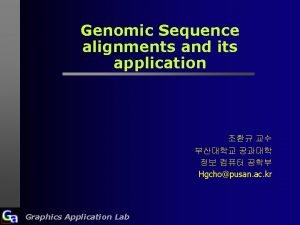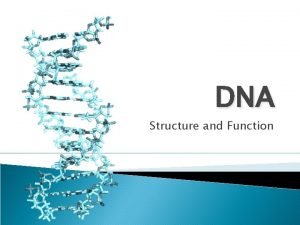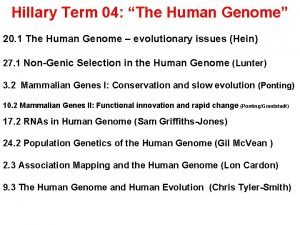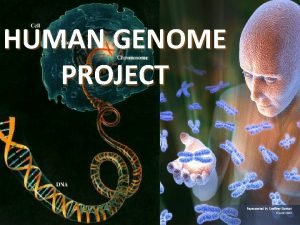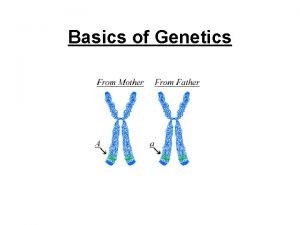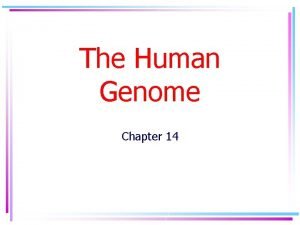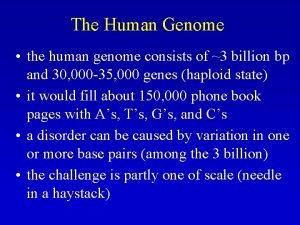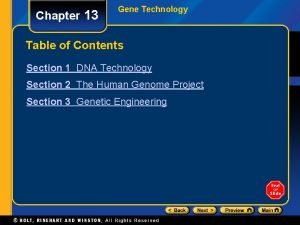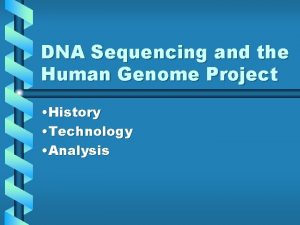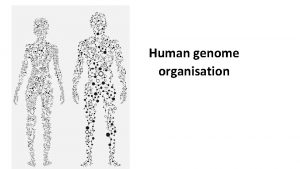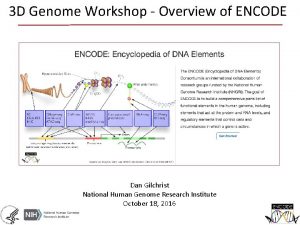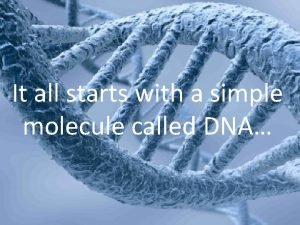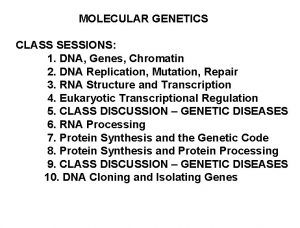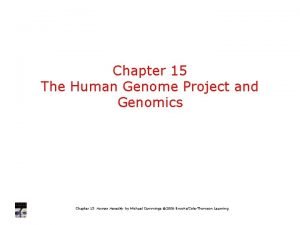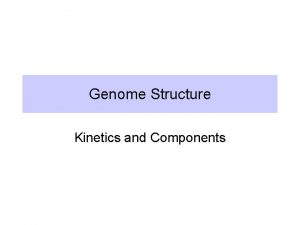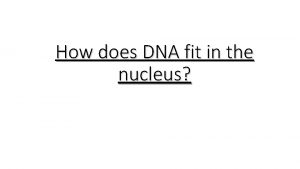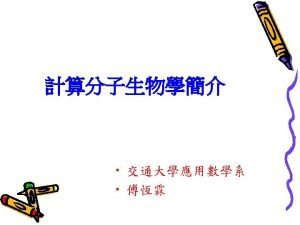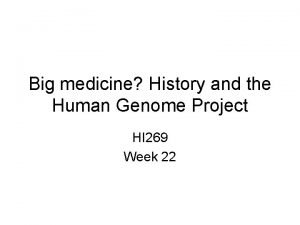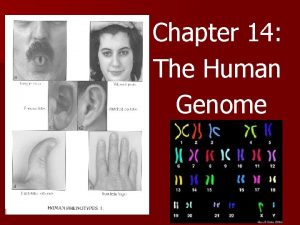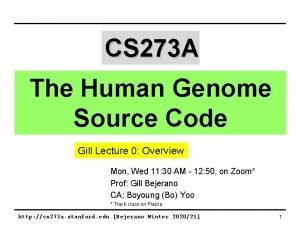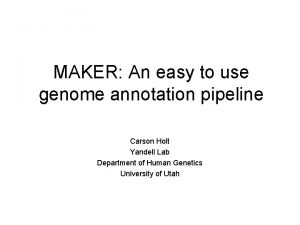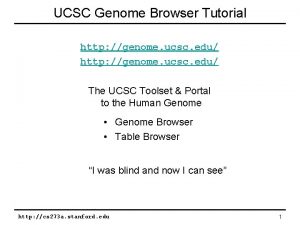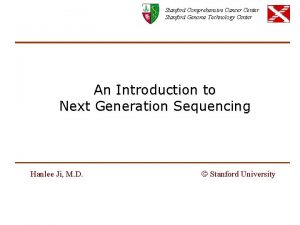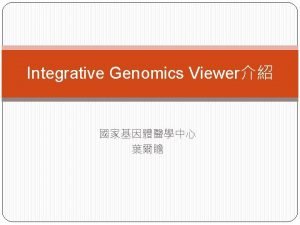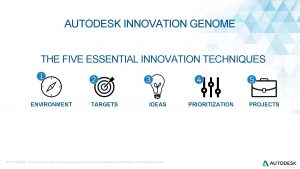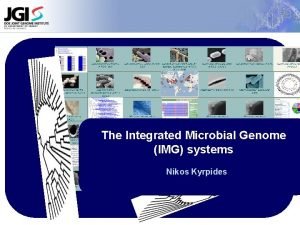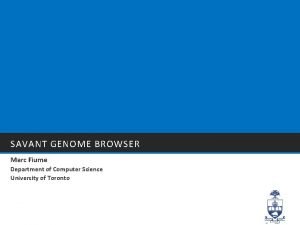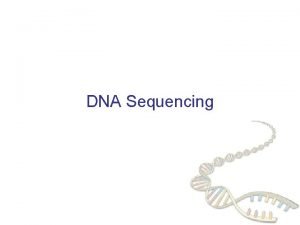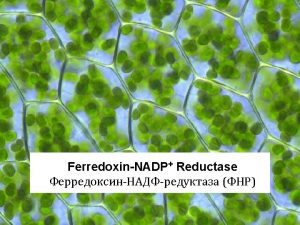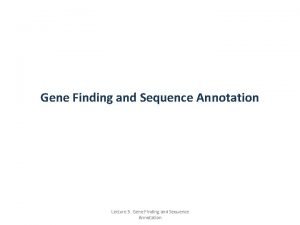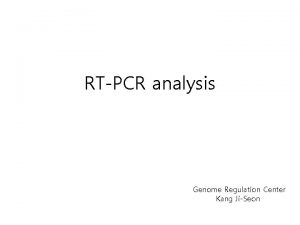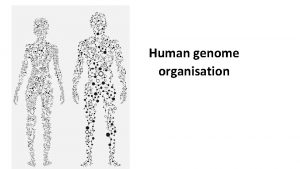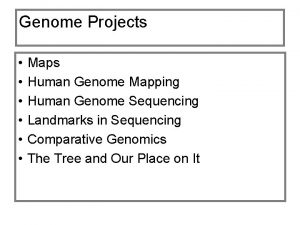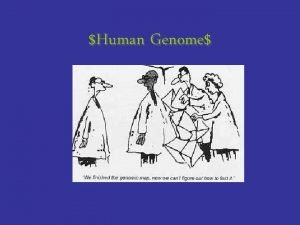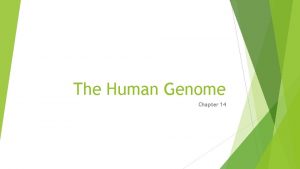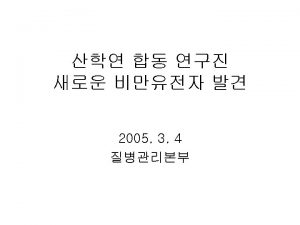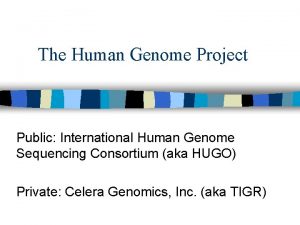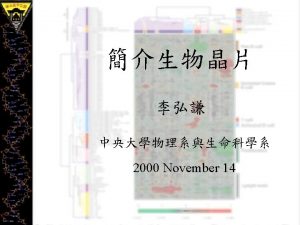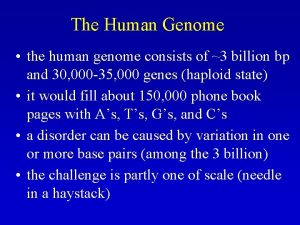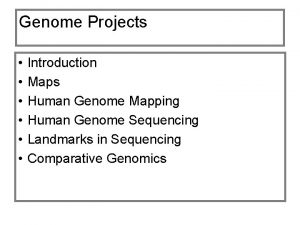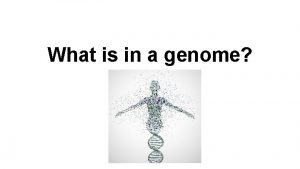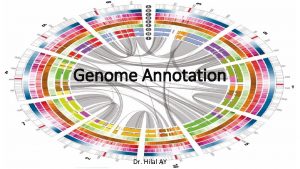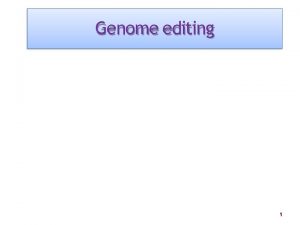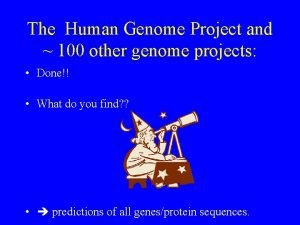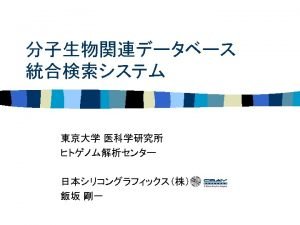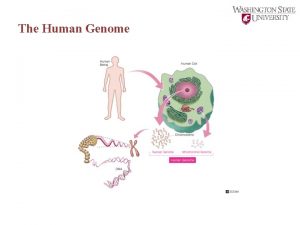The Human Genome Ch 14 The Genome A

































- Slides: 33

The Human Genome Ch. 14

The Genome • A genome is the base sequence of all the DNA in an organism. • A karyotype is a photograph of all of an organisms chromosomes that are froze and stained during metaphase. • There are 23 different genes that are donated from each parent to make you. . 46.

Karyotypes • Can be used to find certain chromosomal abnormalities such as down syndrome.

Types of Chromosomes • Sex Chromosomes determine whether offspring will be male or female. XX- female XY-male Which sex determines the sex of the baby if mom and dad each give one? Sex determination • Autosomes- non-sex chromosomes (traits)

Predictions and People • Pedigrees are used to show a trait and the genes that control it are inherited within a family. • Let’s work a couple and let me explain how they work.


Overview of Genetic Disorders • How many have you heard of?

Recessive Disorders • Tay Sachs Diseasepeople are not able to metabolize a particular lipid, it accumulates in the brain and results in blindness and brain damage. • 1/3600 people • 1/30 carriers • Die by age 5 • Cystic fibrosis results in an excessive secretion of mucus that accumulates in the digestive tract and lungs. • 1/2500 newborns, 1/25 carriers (Caucasian) • ½ live to age of 31

More Recessive • Albinism don’t have skin pigment. • PKU (Phenylketonuria) - accumulation of phenylalanine in tissues; lack of normal skin pigment, mental retardation. • Sickle Cell Anemiablood cells sickle shaped and can’t travel through blood vessels well. • 1/10 Africans are carriers • Co-dominant disorder

Dominant Disorders • In many cases, a • Huntington disease person who has results in the inherited a dominant deterioration of the disorder dies before nervous system. they can pass it on to • Homozygous offspring. dominant-Fatal • 1/500 people • Hh- live to be 40 • 4, 400 known dominant disorders

More Dominant Disorders • Acondroplasiadwarfism • Homozygous dominant-Lethal • Aa- dwarf • Marfan’s- can’t make connective tissue. TALL • Abraham Lincoln • Polydactlyty- extra fingers and toes • 98% of people are recessive

Blood Types • • • Phenotypes A B AB O Who can give to whom? Give a blood transfusion • • • Genotypes IAIA or IAi IBIB or IBi IA IB ii

Environmental Effects • 1. 1 b Different parts of the genetic instructions are used in the different kinds of cells and are influenced by the cell’s environment and past history. • Himalayan rabbits fur color is affected by temperature. • Western white butterfly wing coloration is affected by temp. • Japanese goby fish can change its sex back and forth in response to changes in its social environment. Let’s read about these on page 150 -151.

Human Genes and Chromosomes • Only 2% of DNA in your chromosomes function as genes, those that are transcribed into RNA. • The average human genes consists of about 3, 000 base pairs. • Chromosomes 21 and 22 are the smallest human autosomes.

1. 29 a The action of genes, patterns of inheritance, and the reproduction of cells and organisms account for the continuity of life. 1. 29 b What are ways that inherited characteristics can be observed at the molecular and wholeorganism levels, in structure, chemistry, and behavior?

Sex-Linked Traits • Morgan studied Drosophila and found sex linked genes for eye color. • Human sex-linked traits. – Color Blindness is Xlinked recessive. Xc, Xc Y – Hemophilia- blood doesn’t clot. – Duchenne MD Why would males be more likely to have these disorders?

X-Chromosome Inactivation • Barr Bodies are formed in females because one X is all that is needed in some cells and the other is switched off randomly and forms a dense region in the nucleus. • Cats – You can tell if male or female by spots because genes that controls spots is located on X chromosome. Males will have one color of spot and females will have 2 colors if Barr Bodies are expressed at different times. Why?

Nondisjunction • Nondisjuntion is the failure of chromosomes to separate correctly during mitosis or meiosis. • Monosomy- the zygote has only one copy of a particular chromosome. • Trisomy- the zygote has 3 copies a chromosome. • Most of the times it is disruptive and kills the embryo, but if it survives there can be developmental difficulties.


Examples • Monosomy – Turners Syndrome XO • Affects only girls • Infertility • Minimal physical abnormalities • Trisomy – Trisomy 18 (Edwards Syndrome) – Trisomy 13 (Patau Syndrome) – XXY (Kleinfelters) – XYY – XXX (Triplo X)

Sex Limited Traits • Sex limited traits are only expressed in the presence of sex hormones and are only observed in one sex or the other. • Autosomal • Different colored plumage in male and female animals. • Can you think of any?

Sex Influenced Traits • Sex Influenced traits are expressed in both sexes, but they are expressed differently. • Male Pattern Baldness

1. 27 Humans, along with every other species has a unique DNA sequence. Everyone has a similar cell chemistry and anatomy, but are still different.

Human DNA Analysis • There are roughly 6 billion bp in your DNA. • Labeled DNA probes are used to detect complementary base sequences found in disease causing alleles such as CF or Tay Sachs.

DNA Fingerprinting • 1) 2) 3) 4) Used to determine whether blood, sperm or other material left at a crime scene matches DNA is cut with restriction enzyme Small fragments separated by Gel Electrophoresis. Fragments with variable regions are detected with probe resulting in DNA bands of various sizes. Look for pattern. See page 356.



The Human Genome Project • It’s goal is to sequence all of the DNA on each gene in the human body. • 90, 000 genes…. . 6 billion bases

Rapid Sequencing aka. Shotgun Sequencing • Cutting DNA into random fragments and then determining sequence of bases in each fragment. • Computers put together

Gene Therapy • An absent or faulty gene is replaced by a normal, working gene. • Viruses are used because they can enter a cells DNA. They are modified so they can’t cause a disease. • The DNA fragment containing the replacement gene is spliced to viral DNA and the patient is infected with the modified virus particles, that carry the gene into the cells to correct genetic defects.


1. 15 In biological systems, STRUCTURE DETERMINES FUNCTION. 1. 16 Specific interactions and complexing of smaller levels or organization determine higher levels. This requires a constant input of energy and new material.

Human Genome Review • Click on the following link, choose your textbook and review the material and take self-test for Ch. 14. • Ch. 14 Review
 Genome-to-genome distance calculator
Genome-to-genome distance calculator What is a human genome
What is a human genome Sequencing human genome
Sequencing human genome Human genome project
Human genome project Codom
Codom Sickle cell karyotype
Sickle cell karyotype Euphenics
Euphenics Chapter 13 section 3 the human genome
Chapter 13 section 3 the human genome History of sequencing
History of sequencing Genome organization
Genome organization National human genome research institute
National human genome research institute National human genome research institute
National human genome research institute Human genome size
Human genome size Chapter 15 the human genome answer key
Chapter 15 the human genome answer key Repeated sequences
Repeated sequences Section 14-3 human molecular genetics
Section 14-3 human molecular genetics National human genome research institute
National human genome research institute Human genome size
Human genome size Human genome project
Human genome project Chapter 14 the human genome
Chapter 14 the human genome Human genome project source code
Human genome project source code Maker genome annotation
Maker genome annotation Alternate splicing
Alternate splicing Genome.ucsc.edu tutorial
Genome.ucsc.edu tutorial Stanford
Stanford Raspberry pi 3 model b specifications pdf
Raspberry pi 3 model b specifications pdf Innovation genome project
Innovation genome project Integrated microbial genome
Integrated microbial genome Savant genome browser
Savant genome browser Genome modification ustaz auni
Genome modification ustaz auni Shotgun sequencing
Shotgun sequencing Genome definition
Genome definition Open reading frame
Open reading frame Genome
Genome
